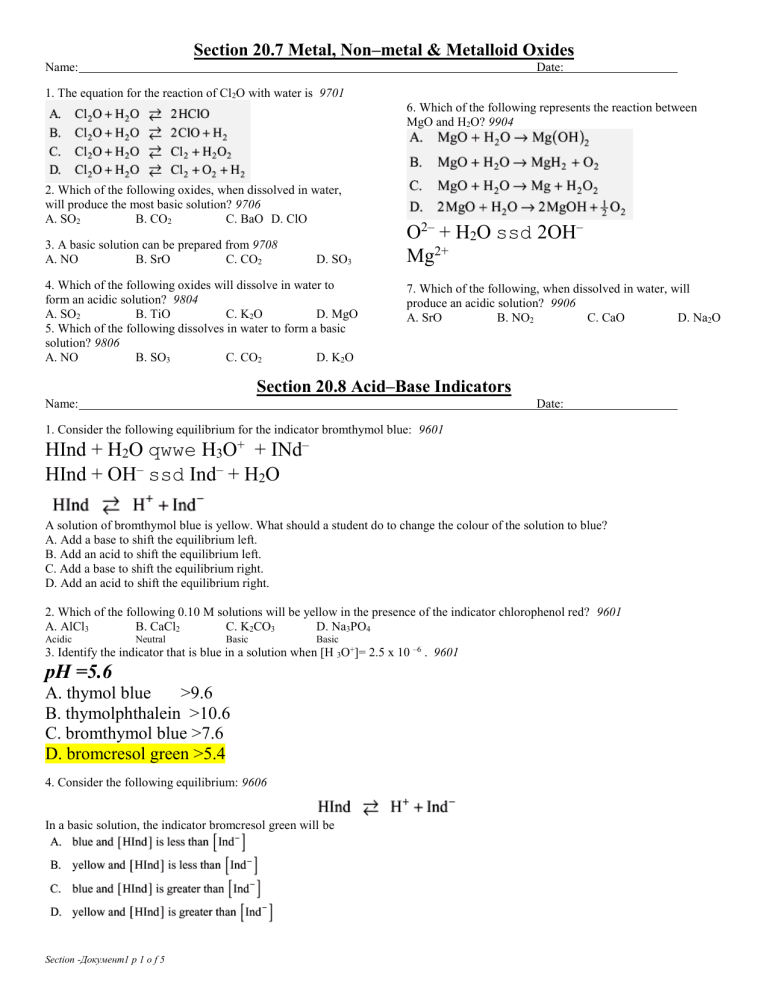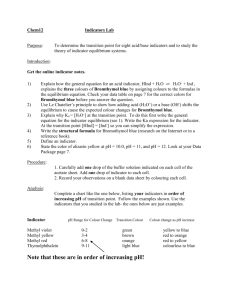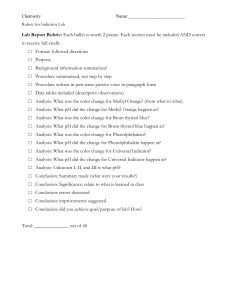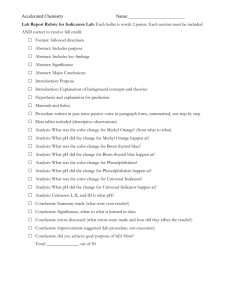20.7,Metals,Non-metals, 20.8 Acid

Section 20.7 Metal, Non–metal & Metalloid Oxides
Name:
1. The equation for the reaction of Cl
2
O with water is 9701
Date:
6. Which of the following represents the reaction between
MgO and H
2
O?
9904
2. Which of the following oxides, when dissolved in water, will produce the most basic solution?
9706
A. SO
2
B. CO
2
C. BaO D. ClO
3. A basic solution can be prepared from 9708
A. NO B. SrO C. CO
2
D. SO
3
4. Which of the following oxides will dissolve in water to form an acidic solution? 9804
A. SO
2
B. TiO C. K
2
O D. MgO
5. Which of the following dissolves in water to form a basic solution?
9806
A. NO B. SO
3
C. CO
2
D. K
2
O
O 2– + H
2
O ssd 2OH
–
Mg 2+
7. Which of the following, when dissolved in water, will produce an acidic solution? 9906
A. SrO B. NO
2
Section 20.8 Acid–Base Indicators
Name:
1. Consider the following equilibrium for the indicator bromthymol blue: 9601
HInd + H
2
O qwwe H
3
O + + INd
–
HInd + OH
– ssd Ind
–
+ H
2
O
Date:
C. CaO D. Na
2
O
A solution of bromthymol blue is yellow. What should a student do to change the colour of the solution to blue?
A. Add a base to shift the equilibrium left.
B. Add an acid to shift the equilibrium left.
C. Add a base to shift the equilibrium right.
D. Add an acid to shift the equilibrium right.
2. Which of the following 0.10 M solutions will be yellow in the presence of the indicator chlorophenol red? 9601
A. AlCl
3
B. CaCl
2
C. K
2
CO
3
D. Na
3
PO
4
Acidic Neutral Basic Basic
3. Identify the indicator that is blue in a solution when [H
3
O + ]= 2.5 x 10
–6
. 9601
pH =5.6
A. thymol blue >9.6
B. thymolphthalein >10.6
C. bromthymol blue >7.6
D. bromcresol green >5.4
4. Consider the following equilibrium: 9606
In a basic solution, the indicator bromcresol green will be
Section -Документ1 p 1 o f 5
5. A 0.10 M solution was tested with four indicators and the following was observed.
9606
The [OH
A. 1 x 10
–10
C. 1 x 10
in this solution is
–6
M
M
B. 1 x 10
–8
M
D. 1 x 10
–4
M
MR pH>6 PPth pH>10
PR pH>8 AY pH<10.1 pH =10.0 pOH=4.0
[OH
–
] = 1 x 10 -4
6. An indicator was added to solutions of different pH and the following was observed: 9608
The indicator is
A. methyl red.
C. methyl orange.
B. thymol blue.
D. bromthymol blue.
7. Consider the following equilibrium for an indicator: 9704
When a few drops of the indicator chlorophenol red are added to a colourless solution of pH 4.0, the resulting solution is
8. Consider the following equilibrium for an indicator:9706
When a few drops of phenol red are added to 1.0 M NaOH, the equilibrium
A. shifts left and the colour of the solution turns red.
B. shifts right and the colour of the solution turns red.
C. shifts left and the colour of the solution turns yellow.
D. shifts right and the colour of the solution turns yellow.
9. Consider the following equilibrium for an indicator: 9708
When a few drops of the indicator methyl red are added to 1.0 M HCl, the colour of the resulting solution is
A. red and the products are favoured.
B. red and the reactants are favoured.
C. yellow and the products are favoured.
D. yellow and the reactants are favoured.
10. The approximate K a
A. 1 x 10
–10
B. 1 x value for the indicator thymolphthalein is
10
–4
C. 4 D. 10
9801
11. Consider the following equilibrium for the indicator phenol red: 9804
Section -Документ1 p 2 o f 5
In a solution with a pH of 7.3, the indicator phenol red is
12. The indicator with K a
4 x 10
–8
is 9804
-log (4 x 10
-8
)= 7.4= pKa or the ½ point of the colour change
A orange IV.
C. thymol blue.
B. neutral red.
D. phenolphthalein.
13. A solution is amber with neutral red and colourless with phenolphthalein. The approximate pH of the solution is 9806
A. 4 B. 6 C. 8 D. 10
14. Consider the following equilibrium for an indicator: 9808
In a solution with a pH of 6.8, the colour of bromthymol blue is
15. The indicator with K a
4 x 10
–8
is 9808 pKa =7.40
A. neutral red.
C. indigo carmine.
B. methyl orange.
D. phenolphthalein.
16. A sample of an unknown solution is tested with the indicator chlorophenol red. The solution turns yellow on the addition of this indicator. The solution could be 9904
Yellow pH<5.2 ACID
A. 1.0 M KF F
–
Base
B. 1.0 M NaCl Neutral
C. 1.0 M Li
2
SO
4
SO
4
2– Base
D. 1.0 M NH
4
NO
3
NH
4
+ Acid
17. A solution contains a mixture of methyl orange, phenol red and thymol blue. When this solution is yellow, the pH is 9904
A. 3.0 B. 6.0 C. 9.0 D. 12.0
18. An indicator changes colour in the pH range 9.0 to 11.0 . What is the value of K a for the indicator?
9906
A. 1 x 10
–13
B. 1 x 10
–10
C. 1 x 10
–7
D. 1 x 10 1
19. Consider the following equilibrium for an indicator:
Which two species must be of two different colours in order to be used as an indicator? 9908
A. HInd and H
2
O
C. H
3
O
and Ind
B. HInd and Ind
D. HInd and H
3
O
20. Which of the following indicators is yellow at a pH of 10.0? 9908
A. methyl red B. phenol red
C. thymol blue D. methyl violet
Section -Документ1 p 3 o f 5
21. Identify the indicator that has a K a
of 1.6 x10
–7
? 0006
A. methyl red B. thymol blue
C. phenolphthalein D. bromthymol blue
PART B: Written Response:
1. Consider the following equilibrium: 9606
When HCl is added drop–by–drop to the yellow solution above, the solution turns orange. Explain why this colour change occurs. (2marks)
HCl makes H+ which reacts with OH-, causing its concentration to drop, thereby shifting the equilibrium to the right and it turns orange.
2. A 1.0 M unknown solution was analyzed and the following was observed: 9606
Classify the unknown as an acid or base indicating whether it is weak or strong. Justify your answer using the data provided. (2 marks)
4.4 <pH <6.0
ACID= Weak because 1.0M solution is pH5,
and dimly glowing conductivity test
3. Consider the salt sodium oxalate, Na
2
C
2
O
4
. 9901 a) Write the dissociation equation for sodium oxalate. (1 mark)
Na
2
C
2
O
4(s)
ssd 2 Na +
(aq)
+ C
2
O
4
2–
(aq) b) A 1.0 M solution of sodium oxalate turns pink when a few drops of the indicator phenolphthalein are added. Write a hydrolysis equation and explain why this salt causes the indicator to change colour. (2 marks)
BASIC SALT
C
2
O
4
2– is a base
C
2
O
4
2– + H
2
O qe HC
2
O
4
–
+ OH
– c) Calculate the equilibrium constant for the hydrolysis in b). (1 mark)
Kb= Kw/Ka(HC
2
O
4
–
)
Section -Документ1 p 4 o f 5
= 1.0x 10
–14
/ 6.4x10
–5
=1.6x10
-10
MC ANS
20.7
1.A 2.C 3.B 4.A 5.D
6.A 7.B
20.8
1.C 2.A 3.D 4.A 5.D
6.B 7.D 8.B 9.B 10.A
11.D 12.B 13.C 14.B 15.A
16.D 17.B 18.B 19.B 20.A 21.D
Written: 1) HCl makes H+ which reacts with OH-, causing its concentration to drop, thereby shifting the equilibrium to the right and it turns orange.
Section -Документ1 p 5 o f 5






